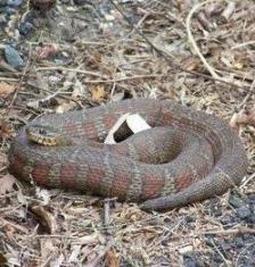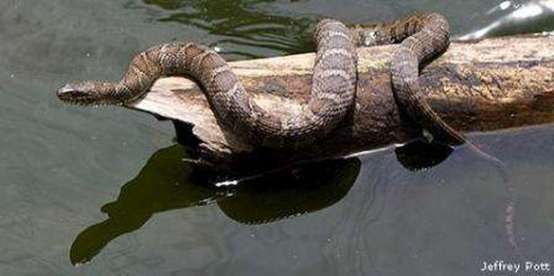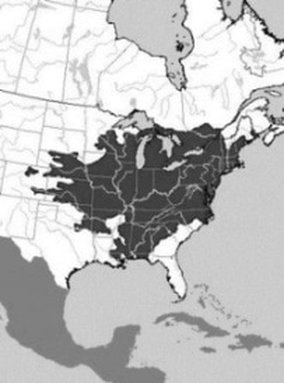Northern Water SnakeNerodia sipedon |

Custom Search
|
|
The northern water snake (Nerodia sipedon) is a medium to large non-venomous snake native to North America, that belongs to the Colubridae family. These snakes are found from Maine to the coast of North Carolina, northwestern South Carolina and Georgia to southern Alabama and eastern Louisiana, west to eastern Colorado and northeast through Minnesota to southern Ontario and southern Quebec.
They are also considered an invasive species in California where they were introduced and compete for food resources with the native species like the giant garter snake (Thamnophis gigas). The northern water snake can be found near many aquatic habitats like lakes or ponds, streams, rivers, swamps, marshes, canals, ditches, bogs even salt marshes. They can live from sea level to about 4,800 feet (1400m) high, with a preference to open areas that provide basking spots and relatively still waters. The northern water snake range in color from gray, brown or brownish-black to reddish. Their pattern consists of dark crossbands on the neck area, and in mid-body area, they have alternating darker blotches on the back and sides that sometimes merge to form bands. As they get older their color will darken and some specimens become solid brown or black. The belly is yellow, white, orangish or gray, with black or reddish-brown crescent-shaped spots. They have keeled scales. The juveniles pattern and color are similar to that of as adult snakes although are more vivid.
The northern water snake reaches an adult size of 4,5 feet (137 cm), there is some sexual dimorphism as females are usually larger than males. This is a very common species and often encountered by humans but their color and pattern mean that they are commonly mistaken for the venomous copperhead or cottonmouth.
They are more active during the day and often seen in groups basking on stumps, rocks or brush but are also active at night. These are solitary snakes except during the mating season or hibernation when they will often share their nest with other snakes. The northern water snake isn't venomous but if cornered or captured, it won't hesitate to defend itself biting repeatedly, defecating and releasing a foul smelling musk. A large adult can inflict a painful bite, which can bleed profusely since their saliva contains a mild anticoagulant. They will try to quickly flee from danger, often swimming off across water or by diving below the surface. They are preyed on by larger snake species, such as milk snakes and black racers, but also by birds, skunks, snapping turtles, raccoons, and foxes. The northern water snake lifespan in the wild is unknown, but have been known to live more than 9 years in captivity. Subspecies
There are 4 subspecies of northern water snakes currently recognized. Northern water snake (Nerodia sipedon sipedon - Linnaeus, 1758) - Found in northern Maine to North Carolina, west to central Tennessee, northern Indiana, and Illinois, west to eastern Colorado, northeast to Minnesota and southern Ontario and Quebec in Canada. Lake Erie water snake (Nerodia sipedon insularum - Conant & Clay, 1937) - Found on a group of islands in western Lake Erie, and the Marblehead peninsula in Ohio. Midland water snake (Nerodia sipedon pleuralis - Cope, 1892) - Found in Georgia and northern South Carolina, through eastern Louisiana to Alabama and north to Illinois and southern Indiana, west to the eastern part of Oklahoma. Carolina water snake (Nerodia sipedon williamengelsi - Conant & Lazell, 1973) - Found in North Carolina, in both mainland coast of Pamlico and Core sounds counties and the Outer Banks Islands. Diet / Feeding The northern water snake diet includes birds, small mammals, fish, frogs, tadpoles, worms, large insects, turtles, leeches, crayfish, salamanders, carrion and other snakes. These snakes are known to herd schools of fish or tadpoles to the water's edge where they can capture several at one time. They hunt both during the day and at night, these snakes aren't constrictors, they will simply swallow the prey whole, dead or alive. Reproduction The northern water snakes emerge from hibernation in late March or April and mate soon after, in April and June, usually in or near their hibernation sites. But local temperatures and latitude cause some variation in these times. The species is a live-bearer, meaning that females don't lay eggs like most snakes. Instead, the female carries the eggs inside the body and gives birth to live baby snakes, each one around 6 to 12 inches long. After a gestation period that lasts anywhere from 3 to 5 months, the hatchlings are born between August and October. A single female may have as many as 30 young at a time, with an average of 8 per litter. But especially large females may have larger litters up to 99 offspring. There is no parental care and the young snakes are on their own as soon as they are born and are able to hunt and caring for themselves. The females are sexually mature at 3 years old, while males are able to reproduce when they reach around 2 years old. Conservation / Threats The northern water snake is still abundant throughout its range, but they are often killed out of fear and confusion with other venomous species, such as the copperhead, cottonmouth/water Moccasin or even rattlesnakes. The Lake Erie watersnake subspecies was listed as an endangered and threatened species in 1999, due to human eradication and also habitat loss and degradation. With the conservation efforts, the initial population of only 1,500 adults recovered to more than to 11,000 individuals and it was removed from the list in August 2011. Ironically their recovery was probably helped by the introduction of an invasive species. The Eurasian round goby (Neogobius melanostomus) was introduced into Lake Erie in the mid 90's, and it became an abundant food source for the Lake Erie watersnake, today it accounts for about 90% of their diet.
|
Did You Know?
Africa's deadly black mamba is the world’s fastest snake, slithering at speeds up to 20km/h. Scientific classification |
© 2014 Snake Facts About Us | Privacy Policy | Contact





